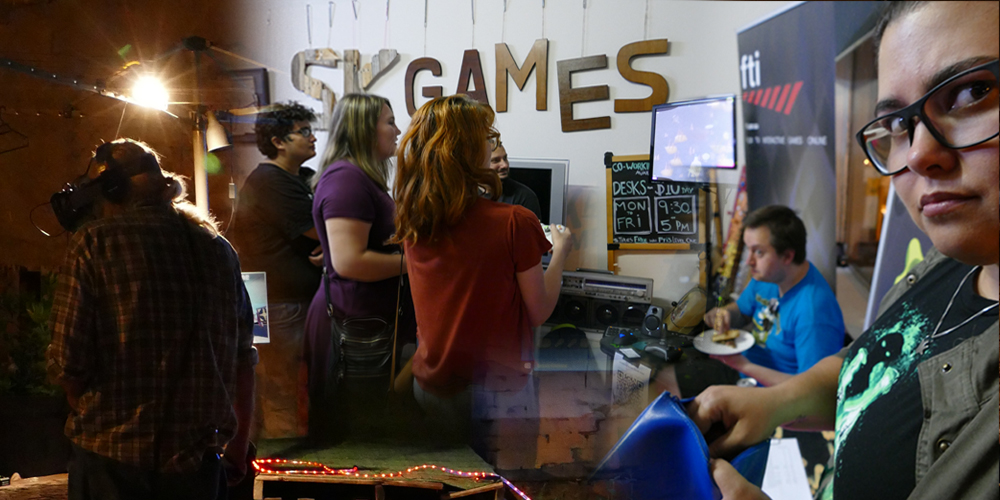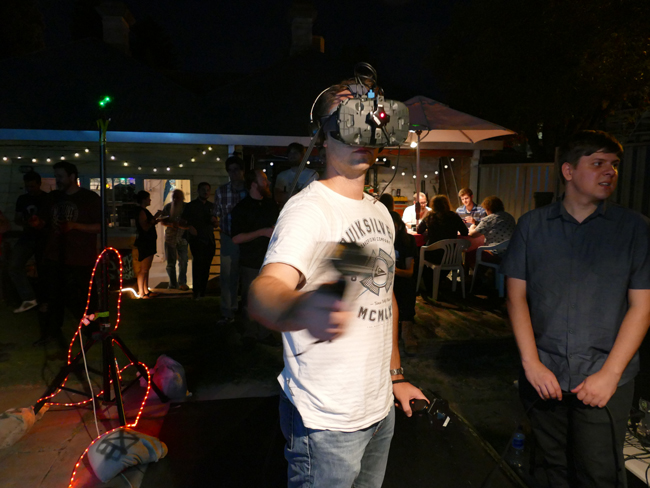

This month’s Playup session featured projects from the recent Global Game Jam, an annual event bringing together teams from around the world with the shared goal of creating a game in 48 hours. A common time limit is imposed in order to promote innovative thinking on the part of contributors, who are encouraged to extend their collaborative and creative skills through the development of a working prototype (many of which go on to become fully realised games). This year’s theme was ritual, one that inspired diverse submissions from teams across several Perth locations, with Murdoch entries considered among the more offbeat or unconventional.
Symphony of the Machine
Described by contributor Lisa Rye as a ‘mechanical raindance’, Symphony of the Machine utilizes a HTC Vive. The VR components allow a player to explore the interior of a futuristic biodome with view of a distant landscape. A glowing interface recalls arcane symbols, in attempts to identify the combination of elements necessary to support alien plant growth. The control method was simple enough to grasp in a single sitting and I managed to avoid the nauseating vertigo of past experiences with stereoscopic headsets. Instead, I felt calmly immersed in the virtual surrounds and rather oblivious to the view of my bumblings projected on SK’s back wall for all to see.

Needs More Cats
Described on the Game Jam site as ‘A game that isn’t about butterflies, or is it?” A 2d sprite awakes in a minimalist style polygon apartment to the sounds of heavy rain and moody ambient tones. After navigating its one-way loop and with repeated futile attempts to use the toaster or pick up a coffee, I was left to ponder the possibility of an existential narrative inspired by the day to day life of an office worker caught in a similar endless loop. Stark and sombre cubic elements are relieved by a bold pattern of color design (indeed reminiscent of a rothko-esque butterfly).
Ritual Failure
Humbly described as a ‘running simulator’ by developer Grae saunders, Ritual Failure might also be pinned as ‘procedural mushroom dungeon crawler’. The game involves a musical co-op element where bizarre looking guardian creatures are summoned to protect players from hordes of bats, a defense tactic with somewhat unpredictable results. Part of a five-strong team, Grae saw this year’s Game Jam as an opportunity to extend his graphics skills in order to better work with artists in his regular role as programmer.

Must
Created by solo game jammer Vivien Lengeek, Must is an exploration into what she describes as “everyday compulsive activities”, the results of which approach a form of touch-based interactive poetry. The game takes on an appropriately minimalist appearance, mirroring a particularly prevalent form of compulsive disorder that tends to reinforce a single repetitive activity to the exclusion of all others. Developed using Adventure Engine Twine, it’s an example of a game that attempts to make a personal statement rather than focus on more familiar entertainment aspects.
Azimuth
Described by playtester Nick Ballantyne as a mixture of resource collection, positioning and timing, Azimuth centres on the arrangement of priest/acolyte pieces among Stonehenge-like standing stones, with various buffs to your resources enhanced by the passing motions of moon and sun. Presented by Raez Game’s Wes Lamont, Azimuth clearly holds future development potential though it took a novice like myself some time to grasp the basic mechanics.. or not?

Golem’s Wake
Featuring all original music, programming and art, Golem’s Wake charges the player to create an army of Guardians to defend their village as they collect and accumulate resources, the skillful management of which allows the creation of ever better Golems to defeat the Slaver Reptilian Overlords. With hand finished art bringing a decidedly ‘outback’ look to its fantasy setting, it will be interesting to see where the concept goes if further developed.
Inti’s Trial
Notable for being the product of a father and son Programmer/Art duo, Inti’s trial is a simple maze game, where the main objective is to navigate the carvings of a totem pole in order to reach a fire. Despite not being particularly flashy in terms of design, the level of finish is nonetheless impressive given the clear limitations and furthermore inspiring, being that it was completed by a team of two.

Bathtime Exorcist
The product of several warped imaginations working from the Murdoch Site, Bathtime exorcist is a game where your housemate Jeb becomes possessed, and Player’s must follow the directions of an ancient recipe book to remove the Demon, with hard to find mythical items substituted by a combination of found household items. As part of the challenge the 4 man team included several Game Jam ‘diversifiers’. ‘One hand tied behind my back’ is an imposed limitation where the control method must be limited to a single hand and ‘Gandhi’s Game’ another, where conflicts must have resolutions based on logic rather than violence.
Banishment
Created by duo Kimberley Larking and Jonathon Durnford, this cooperative card game puts a single player in the role of demon against a team of exorcists attempting to perform their ritual before the time runs out. Featuring some well implemented balancing strategies, Banishment was among the more complete games on the night, with finished decks resulting in a cohesive and appealing presentation. I honestly couldn’t recall a time during the night when the Banishment table wasn’t occupied with keen playtesters.

Mage Masher
(Also known as Nicholas Mage), Mage Masher is a networkable arena style shooter, with noted influences Unreal and other similar era twitch shooters. Featuring procedurally generated maps and a straightforward premise: Mage’s perform summoning rituals to gain elemental powers, which you are then obligated to hurl relentlessly at your opponents! (Developed by: Jacob Kreck, Israel Anderson, Michael McKie and Matt Newton.)
Breakout
Breakout is part joke, part puzzle game, playing on established conventions of the player/world relationship. Apart from the initial, explicit goal of finding your way out of a maze in the fastest time possible, The game lends itself to ambient exploration, featuring a retro-esque voxel look which makes thoughtful use of space balanced with selective detail. Though referencing 70s era classics indirectly through its art style, the game also features a working voxel arcade machine based on the original Atari Breakout!

Mime Madness
A novel concept based loosely on charades, Mime madness involves a co-operative element where one player attempts to free their partner by combining various items in a cauldron, while the other performs a mime in attempts to direct them to the required ingredients. A maiden Game Jam for most of the five-man team, Ben Lemmon described the experience as one with an ‘optimistic start and pessimistic finish’.
An enthusiastic crowd filled SK Game’s backyard space as Game Jammers presented their projects with an openness and humility typical of the Perth Dev community. Despite not having adequate time to fully immerse myself in the night’s tabletop offerings, strong concepts were presented from both digital and traditional camps. All in all this month’s Playup has inspired me to further explore the tabletop side of things, with both a renewed appreciation of the craft and a view towards future Game Jam events here in Perth!











